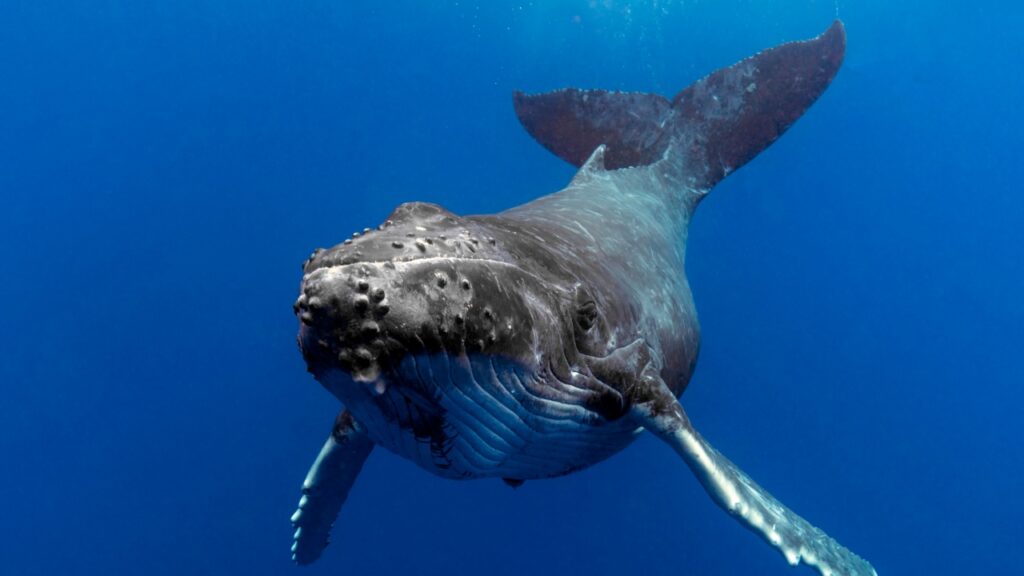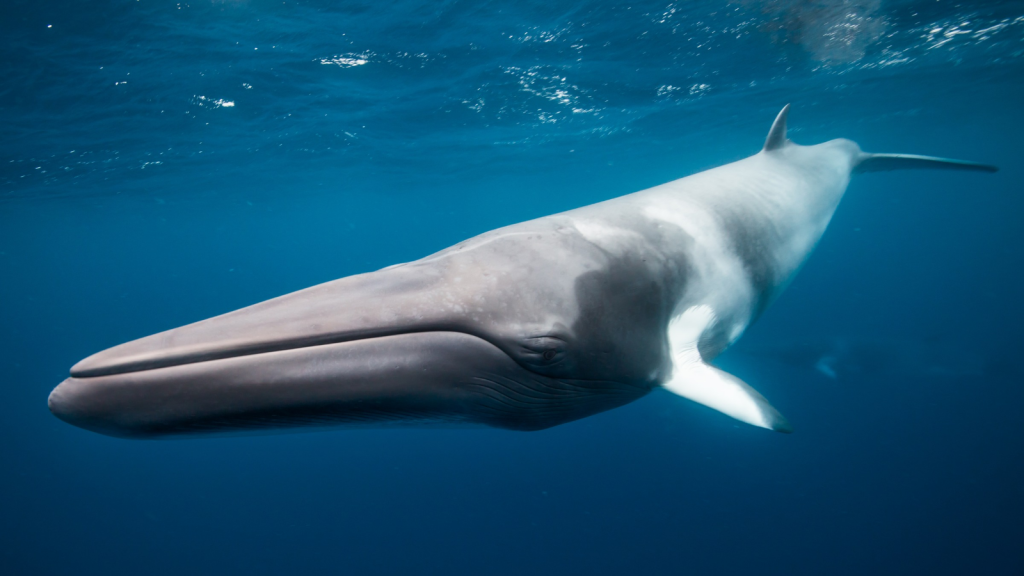The vast, mysterious oceans of our planet are home to some truly impressive creatures. While blue whales often steal the spotlight as the largest animals on Earth, there’s a whole world of marine mammals that rival them in size and wonder. From the depths of the Arctic to the warm waters of the tropics, these ocean giants roam free, each with its own unique features and fascinating behaviours. Ready to meet some of the sea’s most awe-inspiring inhabitants? Prepare to be amazed by these colossal marine mammals that give even the mighty blue whale a run for its money.
The Fin Whale

Often called the “greyhound of the sea,” the fin whale is the second-largest animal on Earth. These sleek giants can grow up to 27 metres long and weigh as much as 80 tonnes. Despite their massive size, fin whales are incredibly fast swimmers, reaching speeds of up to 37 kilometres per hour. Their distinctive asymmetrical colouring, with a white lower jaw on the right side and a dark one on the left, makes them truly unique among whales. Fin whales are filter feeders, consuming up to 2 tonnes of krill and small fish each day.
The Sperm Whale

Made famous by Herman Melville’s “Moby Dick,” sperm whales are the largest toothed predators on the planet. They can grow up to 20 metres long and weigh up to 57 tonnes. These deep-diving champions can hold their breath for up to 90 minutes and plunge to depths of 2,000 metres in search of their favourite prey: giant squid. Their massive, box-like heads contain a special organ filled with a waxy substance called spermaceti, which helps them navigate and hunt in the dark depths. Sperm whales have the largest brain of any animal on Earth, weighing up to 8 kilograms.
The Bowhead Whale

These Arctic giants are built for life in icy waters, with thick blubber layers up to 50 centimetres deep. Bowhead whales can grow up to 18 metres long and weigh up to 100 tonnes. They’re known for their enormous bow-shaped heads, which make up about a third of their body length. These whales can live for over 200 years, making them one of the longest-lived mammals on Earth. Bowheads have the largest mouths of any animal, measuring up to 5 metres long and 4 metres wide.
The North Pacific Right Whale

Once hunted to near extinction, North Pacific right whales are among the rarest of the great whales. They can grow up to 18 metres long and weigh up to 100 tonnes. These gentle giants are easily recognised by the callosities (rough patches of skin) on their heads and their V-shaped blow. Despite their size, they’re known for their acrobatic displays, often breaching and slapping their tails on the water’s surface. North Pacific right whales have the thickest blubber of any whale, measuring up to 30 centimetres thick.
The Southern Right Whale

Cousins to the North Pacific right whale, southern right whales are slightly smaller but no less impressive. They can reach lengths of 15 metres and weigh up to 80 tonnes. These whales are known for their friendly nature and often approach boats, earning them the nickname “right” whales as they were the “right” whales to hunt. They have a unique way of feeding, using their baleen plates to skim the water’s surface for tiny prey. Southern right whales have distinctive heart-shaped blow holes, which produce a V-shaped spout when they exhale.
The Humpback Whale

Famous for their haunting songs and acrobatic displays, humpback whales are true ocean performers. They can grow up to 16 metres long and weigh up to 40 tonnes. Their long pectoral fins, which can reach a third of their body length, give them incredible manoeuvrability in the water. Humpbacks are known for their complex feeding techniques, including bubble net feeding, where they work together to trap fish in a ring of bubbles. Male humpbacks produce complex songs that can last up to 20 minutes and be heard from miles away.
The Gray Whale

These coastal dwellers are known for their incredible migrations, travelling up to 20,000 kilometres round trip each year. Gray whales can grow up to 15 metres long and weigh up to 35 tonnes. They’re easily recognised by their mottled gray skin and lack of a dorsal fin. Instead, they have a series of bumps along their back called knuckles. Gray whales are bottom feeders, often rolling on their sides to scoop up sediment and filter out small prey.
The Sei Whale

Named after the Norwegian word for pollock (a fish that often appears alongside them), sei whales are the third-largest baleen whale. They can grow up to 20 metres long and weigh up to 50 tonnes. Sei whales are known for their sleek bodies and tall, sickle-shaped dorsal fins. They’re also one of the fastest of the great whales, capable of short bursts of speed up to 50 kilometres per hour. Sei whales have a unique feeding strategy, often skimming the water’s surface with their mouths open to catch prey.
The Bryde’s Whale

Often confused with sei whales, Bryde’s whales are named after Johan Bryde, a Norwegian whaler. They can grow up to 16 metres long and weigh up to 40 tonnes. These tropical and subtropical whales are unique among baleen whales for their ability to change their diet seasonally, switching between fish and krill. They’re also known for their three distinct ridges on their rostrum (upper jaw). Bryde’s whales are one of the few baleen whales that don’t migrate, instead staying in warm waters year-round.
The Omura’s Whale

One of the most recently discovered baleen whales, Omura’s whales were only recognised as a distinct species in 2003. They can grow up to 12 metres long and weigh up to 22 tonnes. These elusive whales have a unique asymmetrical colour pattern, with the right side of their lower jaw being white and the left side dark. They’re rarely seen and much about their behaviour remains a mystery to scientists. Omura’s whales are known to produce a distinctive, low-frequency vocalisation that can travel long distances underwater.
The Minke Whale

The smallest of the baleen whales, minke whales still pack a punch in terms of size. They can grow up to 10 metres long and weigh up to 10 tonnes. These agile swimmers are known for their curved dorsal fins and distinctive white bands on their flippers. Minke whales are often curious about boats and may approach to investigate, making them popular with whale watchers. They have a unique feeding technique called “gulp feeding,” where they swim through schools of fish with their mouths wide open.
The Beluga Whale

Often called “sea canaries” due to their varied vocalizations, beluga whales are unmistakable with their pure white colour and bulbous foreheads. They can grow up to 5.5 metres long and weigh up to 1.6 tonnes. Belugas are highly social and are often seen in large pods. Their flexible neck allows them to turn their heads in all directions, a unique feature among whales. Belugas have a thick layer of blubber that helps them survive in Arctic waters and gives them their distinctive rounded shape.
The Narwhal

Known as the “unicorns of the sea,” narwhals are famous for their long, spiral tusks. These tusks are actually elongated canine teeth that can grow up to 3 metres long. Narwhals can reach lengths of 5.5 metres and weigh up to 1.6 tonnes. These Arctic dwellers are rarely seen outside their icy habitat and have a diet that includes halibut, cod, and squid. Narwhals can dive to depths of up to 1,500 metres, spending up to 25 minutes underwater in search of food.
The Orca (Killer Whale)

Despite their name, orcas are actually the largest member of the dolphin family. They can grow up to 9 metres long and weigh up to 6 tonnes. Known for their distinctive black and white colouring, orcas are apex predators with a diverse diet that can include fish, seals, and even other whales. They’re highly intelligent and social, living in complex family groups called pods. Orcas have different dialects depending on their pod, with each group having its own unique set of vocalizations.
The Steller Sea Lion

The largest of the eared seals, Steller sea lions are impressive marine mammals. Males can grow up to 3.3 metres long and weigh up to 1.1 tonnes. These powerful swimmers are known for their loud roars and impressive agility on land despite their size. Steller sea lions are found in the North Pacific, from Japan to California, and play a crucial role in their ecosystem. They have incredible diving abilities, capable of reaching depths of up to 400 metres in search of prey.
15 Terrifying Prehistoric Creatures That Aren’t Dinosaurs

When we think of prehistoric beasts, dinosaurs often come to mind first. But the ancient world was filled with many other terrifying creatures that would give even the fiercest dinosaurs a run for their money. Let’s dive into the murky waters and dense forests of prehistory to meet some of these nightmarish animals that once roamed our planet.
Read More: 15 Terrifying Prehistoric Creatures That Aren’t Dinosaurs
Modern Sea Monsters | 15 Massive Marine Mammals Still Roaming Our Oceans

The oceans of our planet are home to some of the most awe-inspiring creatures on Earth. These marine mammals, with their enormous size and incredible adaptations, seem alien or prehistoric. But an actual up-close interaction with one of these incredible creatures is life-changing. Their lives and sheer size might be unfathomable, but their intelligence and magnificence is clear for all to see. From the largest animal to ever exist to deep-diving behemoths with teeth as big as your arm, these creatures are awe-inspiring and remind us why we need to do more to save our oceans before it’s too late.
Read More: Modern Sea Monsters | 15 Massive Marine Mammals Still Roaming Our Oceans
Meet the Wolf Spider | One of Britain’s Biggest Spiders

Wolf spiders are a remarkable group of arachnids found across the UK and around the world. These agile hunters get their name from their wolf-like hunting style, actively chasing down prey rather than spinning webs. With their large eyes and hairy bodies, wolf spiders might look intimidating, but they’re actually quite beneficial to gardens and homes. These spiders help control pest populations and are generally harmless to humans. From their unique parenting techniques to their impressive hunting skills, wolf spiders are full of surprises.
Read More: Meet the Wolf Spider | One of Britain’s Biggest Spiders
Becky is a fervent wildlife enthusiast and pet care expert with a diploma in canine nutrition. Her love for animals stretches beyond the domestic, embracing the wild tapestry of global fauna. With over a decade of experience in animal welfare, Becky lends her expertise to OutlandishOwl through insightful articles, captivating wildlife information, and invaluable guidance on pet nutrition. Her work embodies a deep commitment to understanding the intricate lives of animals and a passion for educating others on sustaining natural habitats. Becky's hands-on conservation efforts and her knack for translating complex dietary science into practical pet feeding tips make her an indispensable voice for creatures great and small.




